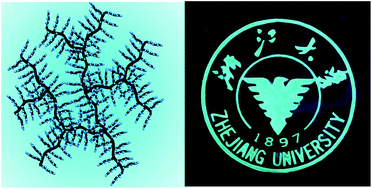Multifunctional dendritic molecular brushes (DMBs) with pendent poly(glycidyl methacrylate) (PGMA) chains were synthesized via a sequential reversible addition–fragmentation chain transfer (RAFT) polymerization approach. By controlling the kinetics of the polymerization, DMBs with a high number-averaged molecular weight (Mn) of ∼1.4 × 106 g mol−1 and narrow polydispersity index (PDI) of 1.50 were obtained. DMBs were reacted with sodium azide, giving rise to giant macromolecules with a high density of hydroxyl and azide bifunctional groups. Pyrene moieties (with a conventional chromophore) were efficiently attached to the DMBs by esterification, affording solution-emissive blue-light DMBs. Ultrahigh excimer emission at 475 nm was achieved for these fluorescent DMBs at a very low concentration of pyrene (∼10−7 mol L−1). Alternatively, tetraphenylethylene (TPE, with an aggregation-induced emission (AIE) chromophore) units were attached to DBMs with a conversion of 100% by copper-catalyzed alkyne–azide click chemistry. The solid-state-emissive blue-light TPE-functionalized DMBs exhibited typical AIE (rather than aggregation enhanced emission, AEE) effect which was rarely observed for dendritic scaffolds and its quantum yield at aggregated state is two times higher than that of fluorophore monomer. Such topology-induced unusual emission phenomena were attributed to the cage effect of DMBs.

You have access to this article
 Please wait while we load your content...
Something went wrong. Try again?
Please wait while we load your content...
Something went wrong. Try again?


 Please wait while we load your content...
Please wait while we load your content...